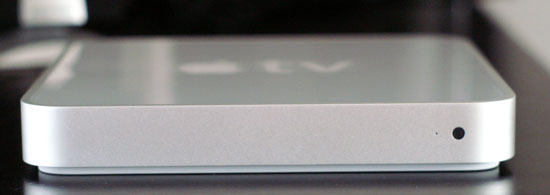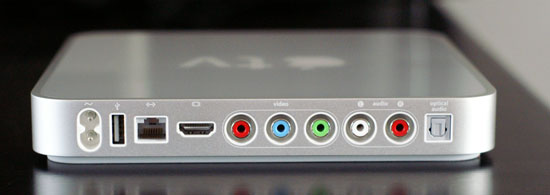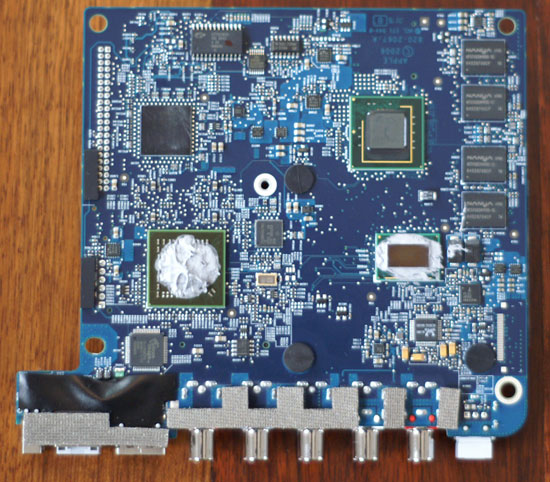Apple TV - Part 2: Apple Enters the Digital Home
by Anand Lal Shimpi on March 26, 2007 1:22 AM EST- Posted in
- Mac
Touch it, Bring it
The Apple TV is a low profile device, measuring 7" on each side and only 1.1" high. It's not going to do a good job blending with other home theater components as it is distinctly Apple; it looks a lot like a thinner, flattened Mac mini.

In traditional Apple style the device's form is very simple, there's not so much as a power button on the unit. On the front you've got an IR receiver for the remote and a single power/activity LED. When the system is booting the LED blinks amber, when ready for use it's solid white, and each time it receives a command from the remote it blinks.
The sides of the unit are bare and in the back you've got a row of ports. Given the target market for the unit, Apple went with strictly modern video outputs. The Apple TV only works via HDMI, component or DVI outputs (the latter through an HDMI to DVI converter). Apple doesn't provide you with any cables other than the power cord, so your choice of output will be met with an additional expense to buy the cable.

Complementing the HDMI and component video outputs are two audio outputs: stereo RCA and optical. Of course if you run HDMI to your display you don't need another cable for audio.
What powers the Apple TV? If you read Part 1 of our coverage we discovered that the unit is powered by an Intel Pentium M based on the Dothan core. The ultra low voltage (ULV) Pentium M runs at 1GHz with a 400MHz FSB and features a 2MB L2 cache. Apple chose Intel's 945G chipset but the graphics output is driven by an NVIDIA GeForce Go 7300. The Apple TV currently ships with 256MB of DDR2 system memory and 64MB of GDDR3 for the NVIDIA GPU.

The unit ships with a 40GB 2.5" PATA drive, and our Apple TV happened to use a 4200RPM Fujitsu drive. Upgrading the hard drive appears trivial; a simple swap should suffice, though of course you'll have to copy the contents of the disk over first. The Apple TV's integrated 802.11n wireless is driven by a Broadcom mini-PCI card inside the device; Realtek powers the built in 10/100 Ethernet.
A quick rundown of the specifications paints Apple TV as a notebook without a screen, and a fairly powerful one at that, given the target market. For a box that is only going to be playing relatively light content, Apple made sure it was more than powerful enough.










48 Comments
View All Comments
rexian96 - Tuesday, March 27, 2007 - link
The video in mini is very crippled though. At least this one has a 7300 chip which would help in H264 decoding. I'd say an XBOX 360 is a much better choice (price wise) if you have an MCE PC around, or nothing beats an HTPC.feraltoad - Thursday, March 29, 2007 - link
I didn't even think of that ninjit. You guys are both right. The Video does suck in the MacMini. -Intel GMA 950 graphics processor with 64MB of DDR2 SDRAM shared with main memory(1)-I think this means no way in hell is Apple gonna up the MacMini to 7300 graphics cuz if they did it really would take tard to buy an apple TV over a macmini when ur alreayd willing to shell out 300. Looking at that the Apple TV looks really insane. And even that looks crazy if Microsoft puts in a HDDVD drive now that the 360 has HDMI. Also, PS3 really flubbed up IMO by not leveraging the media center xtnder aspect since it would be preferable to the MacMini to my mind for an entertainment machine considering the gaming and the BR drive since they are ~same price. I here PS3 can do media extending work, but I don't here much from anyone about it. This crap makes me mad. The only "convergence" I ever see are companies with what seem like kick-ass winning products that ultimately "converge" into the s#it hole. They need to just make an extender that only relays video and audio but digitally (and relays commands) for those who want cable free extension. Til then I'll have to stick to my "30 dollars worth of cables" as someone else suggested.
Novaoblivion - Monday, March 26, 2007 - link
I just picked one up yesterday evening and have been enjoying it so far. I bought it after having heard that it has been hacked to play xvid files :D.Trisped - Monday, March 26, 2007 - link
What is so great about the 7300 that it warrants the statement, "http://www.anandtech.com/mac/showdoc.aspx?i=2952&a...">even with the help of the GeForce 7300." A 7300 doesn't rate high on the processing side no matter how I look at it. Now if it was a 7800 or 7900 or an ATI 1800 or 1900, or better yet a 8800, then yes I would say that the statement applied. I just don't see it for a 7300 GO GPU.Fast Forward is when you play the video back at an accelerated speed (1.5x, 2x, 4x, 8x, 16x, etc). What is described http://www.anandtech.com/mac/showdoc.aspx?i=2952&a...">here, "Fast forwarding through video content is done very well: simply tap the forward button on the remote to skip ahead by a fixed interval and the player jumps ahead"here is more of a skip ahead, since you are skipping some video to move forward, or ahead, in the video.
Trisped - Monday, March 26, 2007 - link
Also, why was the review so tame? Normally Anandtech drills anything that isn't perfect, but this one was more of a "for your info" type review.We should we expect a compare contrast between the AppleTV and the XBox360?
rexian96 - Monday, March 26, 2007 - link
Didn't see it mentioned, but I am assuming it supports MP4 container only to be compatible with iTune. In that case, no Dolby/DTS sound tracks. And since it doesn't have analog 5.1/7.1 output, I think it's safe to assume stereo is the best audio you can get? Hmmm, like someone said it's just an ipod with video out & no display.If these assumptions are right, I think it's safe to say that it's NOT targeted towards enthusiasts.
Questar - Monday, March 26, 2007 - link
Of course it's not. This is targeted at the mass market.archcommus - Monday, March 26, 2007 - link
Every review of a device like this just confirms my thoughts even more that if you want this kind of device behind your TV, you're better off just building an HTPC yourself and having a nice gigabit network throughout your home. Then you can have a server PC with hundreds of GB or even over a TB of storage for videos, music, photos, etc., and also with multiple HD tuner cards in it, and then all you need for each TV in your home is a cheap client PC with a good network connection and some old processor and like 40 GB HDD, that can then stream HD television, video, music, photos, YouTube, whatever the hell you want from the server.Sounds a lot better to me.
vision21 - Monday, March 26, 2007 - link
Is not that the solution to lot of these problems? Laptops already have graphics cards that support 1080p resolution. I have seen VGA ports and DVI ports on laptops, but not HDMI or component cable outs. Instead of keeping AppleTV connected to HDTV, can't we connect laptop directly to HDTV? Am I missing something?abakshi - Monday, March 26, 2007 - link
A bunch of laptops now have HDMI outputs, such as the one I'm typing this on (HP dv9000t).But more importantly, that has the same issue as directly plugging in a desktop to your TV -- people don't do it - they want a simple, set-top box type of device, so that's where a Media Center Extender / Apple TV / X360 / etc. comes in.